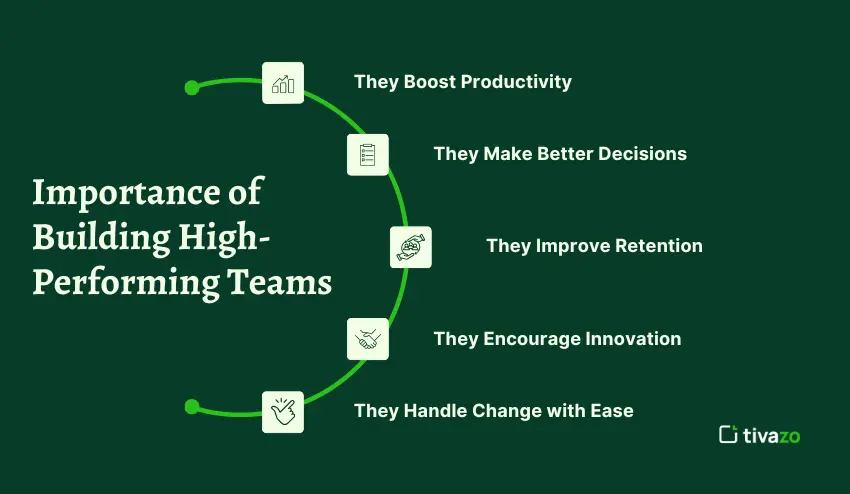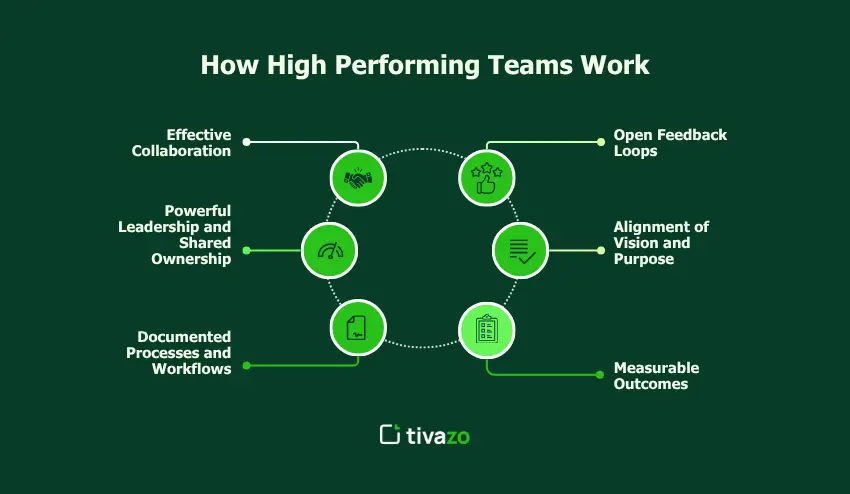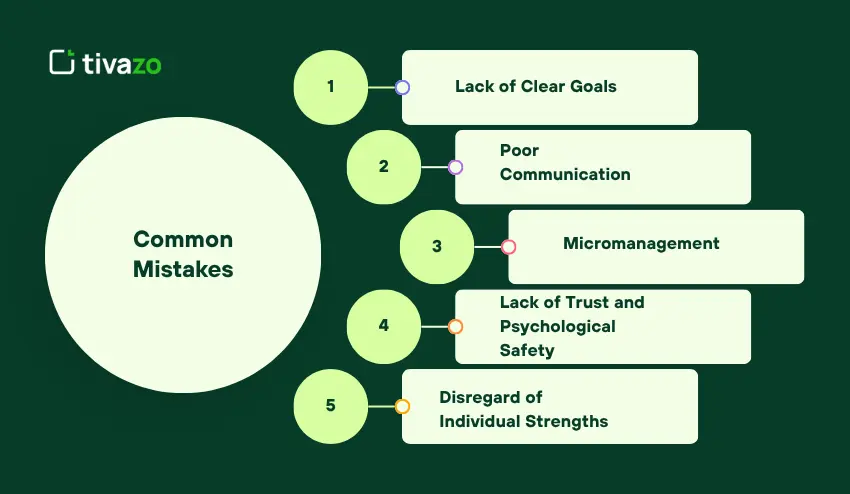Have you ever wondered why certain teams simply work together-faster, more effectively and why they always seem to do a better job than the rest? We call these high performing teams. They are never constructed in one day, nor are they based on chance. Rather they flourish on transparency, faith, and common cause.
By 2025, when the workplace is redesigned around hybrid work, AI tools, and international collaboration, developing a high performing team is not only a leadership objective, but a survival skill. Effective teams adapt more quickly, creatively find solutions to problems and remain motivated despite the obstacles.
This is a guide that simplifies all you need to know about high performing teams such as what they are, how they work and 10 proven ways of creating one that will produce exceptional results.
What Are High Performing Teams?
A high performing team refers to a group of individuals who continually attain excellent outcomes through the taking advantage of the strengths of others, keeping trust, and being focused on a common goal. These are not teams that work together, but work in harmony.
In less complicated words, it is the distinction between a group that works and a group that really works. Each member understands his/her role, is open to communication and owns the results, not only work.
Snippet-friendly definition:
A high performing team consists of people who work together, trust each other, and always go the extra mile to achieve a common objective.
These teams are marked by:
- Effective communication: No one is left in the dark.
- Shared responsibility: Team success or failure is not an individual issue.
- Adaptability: They are quick to adapt to change without missing track.
- Shared purpose: Each activity is associated with a shared mission.
Consider groups such as the Apollo program of NASA or the product team of the iPhone – different talents all sharing a single vision. That is what high performance is all about.
The Importance of Building High-Performing Teams in 2025.
The 2025 workplace will be quicker, more digital, and commonly distributed over time zones. But there is one thing that has not changed, and that is success is still a matter of teamwork. Modern organizations run on high performing teams. They are flexible to change, provide stable output, and enable businesses to remain competitive in a volatile world.

This is why creating high performing teams is the most important thing ever:
- They Boost Productivity
Effective teams are characterized by purpose and trust. They are result-oriented rather than wasting time on confusion or hand-holding. A group that shares priorities and can see through its work processes will produce quicker results with fewer mistakes.
- They Make Better Decisions
Teams that perform well pool together divergent views to identify smarter solutions. Open communication and teamwork enable them to address issues effectively – and make sound decisions that lead to growth.
- They Improve Retention
Individuals remain in the places they are valued. Having a powerful networked team fosters trust, burnout minimization, and engagement. Employees who love working collectively hardly ever consider an alternative.
- They Encourage Innovation
Trust fuels creativity. Naturally, innovation runs in teams where members are comfortable communicating ideas. Imagine how Google or Spotify teams are experimenting all the time – that is collaboration at work.
- They Handle Change with Ease
Flexibility is strength in a rapidly evolving business environment. The teams that perform highly understand how to turn on a dime, how to remain calm when under pressure, and how to maintain productivity even when things are unpredictable.
Simply put, creating high performing teams is not only good leadership, but how companies remain relevant, strong, and future ready.
Key Characteristics of High Performing Teams
All winning teams have some common characteristics. These attributes keep them focused, motivated, and on track – regardless of the difficulty. The first step to creating a high performing team is to understand these characteristics.
- Clear and Shared Goals
Each of the members has a clear understanding of what success is. Goals are focused, quantifiable and are related to the mission of the team. When all are going in the same direction, there will be less confusion and more accountability.
Example: In a software team, each sprint has specific deliverables and success measures. This makes the efforts of everyone to be directly related to the product goals.
- Open and honest communication.
Keeping your team healthy relies on openness. High performers do not hide issues or opinions, they discuss them in a constructive manner. Openness in communication channels, feedback loops, and regular check-ins allow collaboration to occur easier and faster.
- Trust and Respect for Each Other.
Teamwork relies on trust. Team members trust each other to do their job and to be open to different perspectives. Trust also builds confidence and reduces conflict, and helps strengthen relationships over time!
- Accountability
In performing teams, no one is blamed. In high-performing teams, we are all the owners of our results and we own our successes and failures. This shared responsibility supports high performance and ongoing improvements.
- Flexibility and Strength.
Markets are changing, deadlines are changing, priorities are changing. Good teams adapt fast without going astray. Their elasticity enables them to stay in motion despite stress.
- Balanced Skill Sets
An excellent team is composed of diverse talents such as creativity, technical skills, organization, and leadership. This balance enables them to work on complex projects effectively and to learn with each other.
- Continuous Learning
High-performing teams experience expansion as a culture. They look back at their performance, learn through failures and celebrate small wins. It is an attitude that enables them to remain innovative and future-oriented.
A high performing team is in essence, a group that is purposeful, trustful and accountable with a commitment to improve. When these characteristics are combined, extraordinary outcomes are automatic.
How High Performing Teams Work

High performing teams do not occur by chance, they work with well-organized processes, effective teamwork and good leadership. Any organization can emulate their success by understanding how they operate.
- Effective Collaboration
Team members organize their work effectively, distribute duties and capitalize on the strengths of each other.
Example: A marketing team has a Trello board where they allocate tasks, manage deadlines and real-time updates to be sure that handovers are smooth and that no one is doing the same job.
- Powerful Leadership and Shared Ownership.
Leaders direct, but team members are given the authority to make decisions in their duties, which breeds accountability and motivation.
Example: In a product development team, the team lead establishes project objectives, but developers are allowed to determine how features should be implemented, which leads to greater ownership and initiative.
- Documented Processes and Workflows.
Written processes provides efficiency and removes ambiguity. Workflow management allows teams and individuals to focus on the work in front of them while achieving results.
Example: A customer success team uses a step-by-step onboarding process with clients to bring consistency to their role and minimize errors across the team.
- Open Feedback Loops
Ongoing feedback keeps small issues from becoming big ones and enhances performance incrementally.
Example: A sales team has weekly review meetings that allow team members an opportunity to talk about issues and offer solution strategies so that the problems don’t develop.
- Alignment of Vision and Purpose
Every action is aligned in order to engage and bring focus to the team’s purpose.
Example: A fundraising team for a non-profit organization presents the team with their overall financial goal for the year and what that means to the organization. That keeps the team engaged and motivated by their purpose as well as increases transparency.
- Measurable Outcomes
Successful high performing teams have measures of performance that are quantifiable productivity, quality, engagement, or customer satisfaction.
Example: A software team checks the rates of bugs being resolved and the quality of releases and modifies workflows in real-time based on the incoming data to ensure high quality.
Examples of High Performing Teams in Action
It is useful to look at real-life examples of what high performing teams are like and how they work. Here are three notable cases:
Google’s Project Aristotle
Google analyzed hundreds of teams to understand what they have in common to be successful. They discovered that psychological safety, trust, and roles were the crucial aspects rather than personal talent. Openly communicating and supporting teams always performed better than others.
Example: In Google, a research team felt secure in expressing non-traditional ideas without any fear of being judged and generated innovative ways of solving complex problems.
Netflix Culture of Freedom and Responsibility.
Netflix gives employees freedom and responsibility in the process. Their high performing teams are based on clear expectations, trust, and ownership.
Example: A group that focuses on content develops and prioritizes its own projects and is aligned with the company goals, running more creative campaigns faster and more efficiently than a typical team.
Spotify’s Squad Model
Spotify has grouped people into small, cross-functional teams called squads who have complete end-to-end accountability of a given product feature. Squads are independent from one another, but still on the bigger mission, providing both ownership and innovation for the squad.
For example, a group focused on the Spotify mobile app can make experiments, publish changes, and iterate faster because of having a clearly defined purpose and shared ownership.
These examples clearly show that talent does not work in isolation, but rather high performing teams are a result of trust, autonomy, alignment and trust collaboration.
Common Mistakes That Stop Teams from Performing

Even the teams of talents may be in trouble unless some of the pitfalls are avoided. Being aware of these pitfalls allows leaders to avoid poor performance and create stronger and more resilient teams.
1. Lack of Clear Goals
In the absence of clear goals, groups lose track, interests collide, and development halts.
Example: A distant sales team that lacked a common goal and target ended up doing nothing twice, missing deadlines and losing customers.
2. Poor Communication
Poor or vague communication results in confusion, mistakes and frustrations.
Case Study: A product team was unable to communicate with developers and designers, resulting in the late release of features.
3. Micromanagement
Leaders who are too controlling kill initiative and motivation.
Example: A manager who always monitored every task made developers feel disempowered, which decreased productivity and creativity.
4. Lack of Trust and Psychological Safety.
If members of the team are afraid they will face criticism or blame for actions taken, they will refrain from taking risks, engaging in candid conversations, or admitting their mistakes.
Example: To evade blame, a customer service team kept their mistakes hidden, and as a result, the same mistakes occurred again and frustrated their customers.
5. Disregard of Individual Strengths.
Failure to capitalize on the individual talents of team members minimizes productivity and morale.
Example: A design team delegated tasks to code to everyone in equal measure without regard to who was good at development and this slowed down the process and led to frustration.
With these errors corrected, leaders will be able to realize the potential of their teams and establish a high-performing teams, sustainable environment.
Assessing Team Performance
Assessing a team’s performance will give you insights on whether or not your team’s strategies and plans to achieve success are working or not, and it will give you additional evidence for adjustments as needed. Successful teams also rely on both quantitative and qualitative evidence of their success.
Productivity Measurements
To measure the productivity, review the team’s performance against their goals deadlines.
Example: A marketing team can measure the number of campaigns they complete in a quarter while checking the success with their goal, and see potential delay points and efficiency.
Quality of work
Assessing the quality, l originality, and impact of the team’s work, whatever the objective of the work may be!
For example, a software team measures bugs and successful features after the release of code, confirming their quality work.
Interaction and Satisfaction
The overall teamwork experience of the team is positive, or healthy. One way to measure teamwork is through employee engagement surveys, monitoring employee retention rates.
Example: A consulting firm sends out a survey every quarter to team members and measure their satisfaction and collaboration experience and plan an intervention if low scores are reported.
Collaborating and Sharing
You can measure efficiency through teamwork, and how effective team members are in sharing information, conflict resolution, and support of one another.
Example: A project management team logs all of their internal communications, and transfers or tasking both within the project team and across departments to help the work flow smoothly.
Creativity and Problem Solving
High performing teams always think outside of the box with their solutions, yet remain flexible and adaptive to respond quickly and mitigate urgent issues.
Conclusion
Creating high performing teams is not a luxury anymore, but a necessity to organizations that plan to prosper in the year 2025 and beyond. These teams are built on the basis of trust, clear objectives, effective communication, and responsibility to produce outcomes that are much greater than the aggregate of the efforts of individual members.
Any organization can turn ordinary groups into high performing teams by establishing common goals, creating a sense of psychological safety, capitalizing on diverse strengths, and assessing performance regularly. The examples of Google, Netflix and Spotify demonstrate that it is not only talent but structure, culture and constant improvement that make them successful.
Begin to use these strategies today and you will see your teams work together, innovate more quickly, and produce outstanding results. High performance is not merely an objective, it is an attitude, a process.




